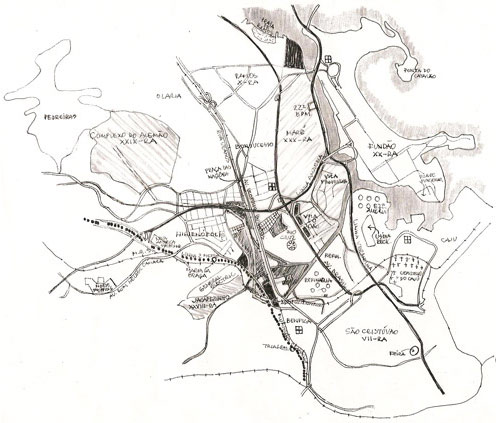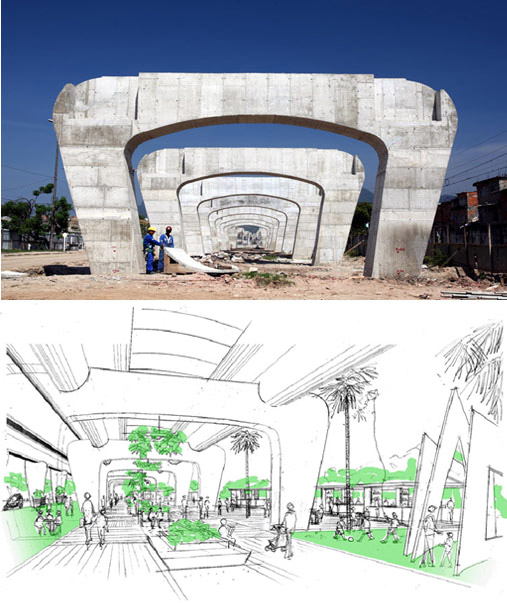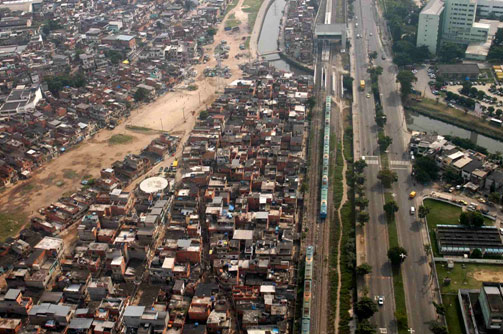| Escritos |
From Oedipus complex to Manguinhos complex: public space as a social connector |
 English English  Français Français

Manguinhos complex: Scheme of reading of the structure of the place
The existence of enormous areas in our cities, where inhabitants are excluded of the benefits of urbanity, affects everybody. We know that when we try to exclude from ourselves something we want to expel, it always returns. There are consequences for the exclusion and the expulsion of parts of us.
The Manguinhos complex is not only an assembly of favelas in Rio de Janeiro, it is also a part “faveled”(excluded) in each one of us, in a process that impoverishes everybody: the ones who are obliged to live in the favela for lack of options, and the ones who live outside the favela.
The Brazilian Institute of Social Studies (IBASE) did an inquiry analyzing the relations between the favela and the “asphalt” (formal city is called like that) which shows that the inhabitants of the asphalt see people in the favelas with suspicion, and the people in the favela see the residents as arrogant. The prejudice rules these relations involving a defensive attitude that, even being fragile and useless, keeps the illusion that the bad is always the other. Big mistake, that brings tragic consequences to the humanity. The struggle of the good against the evil does not have winners. Everybody loses (it is happening in Rio de Janeiro right now).
The psychoanalysis says that love and hate are parts of human being and that from this mixture it can result both the most bizarre things and the most sublime ones: beautiful works of art and hideous crimes.
It is here that the Oedipus complex appears. The Oedipus serves to bar, to intercept and to re-direct the powerful forces of love and hate that make us move.
The Oedipus complex acts like a structure of interdiction that puts all of us in the same condition due to our “incompleteness” and mortality.
We can enlarge our horizon recognizing the limits, incorporating the excluded ones in our life, in our city, and in the world. From the recycling of garbage, the reforestation politics and the creation of conditions to generate work and income, the question is always the same: the reinsertion of humanity in us through the recognition of the other.
The Connective promenade (The Manguinhos Rambla)
The projectual intervention provokes a significant change in the context of the favela, through the creation of a connective new space (Rambla) articulating social facilities (civic center including school, library, legal support office and squares) with the new Manguinhos train station.
This new type of space (inexistent in the city before the project) implies a re-qualification of the broken city with prestigious facilities (public spaces for social interactions and well elaborates buildings).
Amid the divided society, public space works as a number-one factor of socio-spatial regeneration.
In this context, urban design projects need to simultaneously consider physical aspects (infrastructure, urbanism and architecture), social conditions (which include the cultural, economical and existential aspects), ecological issues (that imply mental, social, and environmental questions) and citizens security (which is related to the control of the social territory).
As part of the “urban parti” the sector here presented is an exemplary case selecting Leopoldo Bulhões avenue, the most conflictive fragment (called by Rio residents the “Gaza Strip”) where the railroad was drastically dividing the area.
The project consists of a new landscape design of environmental quality, defined by the conjugation of place, activities, constructions and vegetation. This linear public space is thought as a connector of the informal residential sectors, currently divided by the railway line, which we proposed to elevate.
The main element of the proposal is the public promenade itself, the constitution of an urban pedestrian walkway along the avenue and a new multi modal transportation interchanger (train, bus, taxis, moto-taxis, vans, bicycles) open 24 hours.
This combination of interrelated elements, allowed by the connectivity of the pedestrian promenade, eliminates existing barriers transforming the most problematic sector in the area into one of great virtues: from divider to connector.
The premises for the landscape design takes as reference Flamengo Park in the city of Rio de Janeiro, designed by Roberto Burle Marx, which was conceived as a place of relaxation, sport and culture, with the values of a modern democratic space.
The structuring programs of the Manguinhos project were carefully defined to satisfy the different age groups including sport, culture, and job and income generation facilities. However, within this framework, an emphasis was put in providing children and teenagers with alternative attractions that would integrate these groups to the community and prevents them from being seduced by the drug dealing activity, which is typically a key job generator in the economy of low-income areas of the city.
“City Shaping” means the possibility of re-creating, through social/spatial interventions, the sense of belonging, the perception and the re-inscription of their identities.
Rediscovering ourselves as neighbors, we can also discover new ways of generate connections in the interior of the contemporary city.
The environment needs to be human to the human being, and the human complexity must contain all the complexes: The Oedipus complex and the Manguinhos complex.

Manguinhos promenade
 |
 |
| Study for Manguinhos pedestrian walk-way |
Centralities Scheme |

Manguinhos Aereal view
Du complexe d´Oedipe au complexe de Manguinhos ; l’espace public comme connecteur social
L´existence d´énormes espaces dans nos villes dans lesquels les habitants sont exclus au profit de l´urbanité, affecte tout le monde. Nous savons que lorsque nous essayons d´exclure de nous-même quelque chose que nous voulons expulser, cela fini toujours par revenir. Ce sont les conséquences de l´exclusion et l´expulsion de parties de nous-même.
Le complexe de Manguinhos n´est pas seulement un ensemble de favelas à Rio de Janeiro, c’est aussi une partie « favelisée » (exclue) en chacun de nous, dans un processus qui appauvri tout le monde : ceux qui sont obligés de vivre dans la favela par manque d’options, et ceux qui vivent en dehors de la favela.
L’Institut Brésilien des Études Sociales (IBASE) a réalisé une enquête pour analyser les relations entre la favela et l’ « asphalte » (c’est ainsi qu’est appelée la ville formelle) qui montre que les habitants de l’asphalte sont suspicieux à l’égard des gens des favelas, et les gens des favelas voient les residents comme arrogants. Les préjudices régissent ces relations, entraînant une atitude défensive qui, même si fragile et inutile, donne l’illusion que le mauvais est toujours l’autre. Grosse erreure qui entraîne de tragiques conséquences pour l’humanité. La lutte du bien contre le mal n’a pas de vainqueurs, tout le monde est perdant (et c’est ce qui est en train d’arriver à Rio de Janeiro en ce moment même).
Les psychanalystes disent que l’amour et la haine font parties de l’être humain, et que de ce mélange peuvent résulter à la fois les choses les plus étranges et les choses les plus sublimes : des oeuvres d’art magnifiques, et des crimes hideux.
C’est ici qu’apparaît le complexe d’Oedipe. Oedipe sert à faire obstacle, à intercepter et re-diriger les forces puissantes d’amour et de haine qui nous font avancer.
Le complexe d’Oedipe agit comme une structure d’interdiction qui nous met tous dans la même condition, en raison de notre « incomplétude » et de notre mortalité.
Nous pouvons élargir notre horizon en reconnaissant les limites, en incorporant ceux qui sont exclus de nos vies , de nos villes et du monde. À partir du recyclage des ordures, la reforestation politique et la création de conditions pour générer du travail et du revenu, la question est toujours la même, la réinsertion de l’humanité en nous à travers la reconnaissance de l’autre.
La promenade connective
L’intervention par le projet provoque um changement significatif dans le contexte de la favela, à travers la création d’un nouvel espace de connection (Rambla) articulant des équipements sociaux (centres civiques dont des écoles, bibliothèques, des bureaux d’appui juridique et des places) avec la nouvelle station Manguinhos.
Ce nouveau type d’espace (inexistant dans la ville avant ce projet) implique une re-qualification de la “ville brisée” avec des équipements prestigieux (espaces publics pour des interactions sociales et bâtiments bien édifiés).
Au sein de la société divisée, l’espace public fonctionne comme le facteur numéro un de la régénération socio-spatiale.
Dans ce contexte, les projet de design urbain doivent considérer simultanément les aspects physiques (infrastructures, urbanisme et architecture), les conditions sociales (qui incluent les aspects culturels, économiques et existentiels), les problèmes écologiques (qui incluent les questions mentales, sociales et environnementales) et la sécurité des citoyens (en rapport avec le contrôle du territoire social).
Faisant parti du « parti urbain », le secteur est ici présenté comme un cas exemplaire en selectionnant l’avenue Leopoldo Bulhões, la fragmentation la plus confluctuelle (appelée par les residents la « Bande de Gaza ») où la voie férrée a divisé drastiquement l’espace.
Le projet consiste en un nouveau design paysagé de qualité environnementale définie par la conjugaison des espaces, des activités, des constructions et de la végétation. Cet espace public linéaire est pensé comme un connecteur du secteur résidentiel informel, actuellement divisé par la voie ferrée, que nous proposons d’élever.
L’élément principal de la proposition est la promenade publique en elle-même, la constitution d’une aire piétonne le long de l’avenue et un nouvel échangeur de transports multi-modal (train, bus, taxi, moto taxis, vans et vélos) ouvert 24 heures sur 24.
La combinaison de ces éléments inter-connectés, permis par la connectivité de l’allée piétonne qui élimine les barrières existantes, transformant le secteur le plus problématique en un secteur à grande vertue : du séparateur au connecteur.
Les prémices de ce design paysagé prend pour référence le Parc de Flamengo dans la ville de Rio de Janeiro, élaboré par Roberto Burle Marx, qui fut conçu comme un espace démocratique moderne.
Les programmes structurants le projet Manguinhos ont été définis avec soin pour satisfairee les différents groupes d’âge en ce aui concerne le sport, la culture et les équipements de créations d’emplois et de salaire. De plus, dans ce cadre, un accent fut porté sur l’apport aux enfants et aux jeunes d’activités alternatives pour intégrer ces groupes à la communauté et pour les empêcher d’être séduit par le traffic de drogue, qui reste un emploi clé permettant de générer une économie dans les zones à faible revenu de la ville.
« Le façonnement de la ville » signifie la possibilité de re-créer à travers des interventions socio-spatiales, le sens de l’appartenance, la perception et la ré-inscription de leurs identités.
En nous re-découvrant nous-même en tant que voisins, nous pouvons aussi découvrir de nouveaux moyens de générer des connections dans la ville contemporaine.
L’environnement doit être humain, dirigé vers l’être humain et la complexité humaine, contenir tous les complexes: le complexe d’Oedipe, et le complexe de Manguinhos.
Jorge Mario Jáuregui |